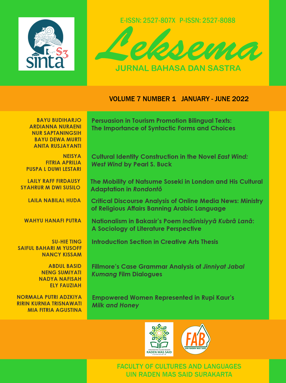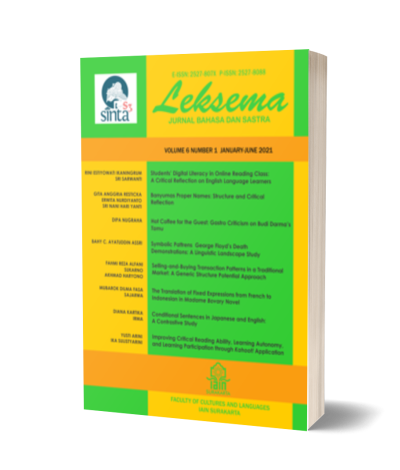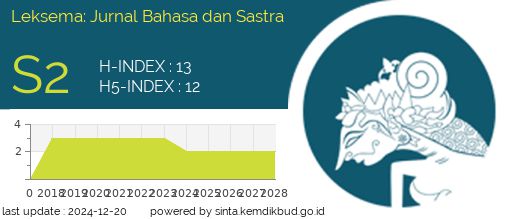CRITICAL DISCOURSE ANALYSIS OF ONLINE MEDIA NEWS: MINISTRY OF RELIGIOUS AFFAIRS BANNING ARABIC LANGUGE
DOI:
https://doi.org/10.22515/ljbs.v7i1.4911Keywords:
critical discourse analysis, Ministry of Religious Affairs, Arabic languageAbstract
The purpose of this research was to describe the micro, mezzo, and macro linguistic aspects of the news discourse ‘Ministry of Religious Affairs banning Arabic language’ on Tempo.co and Republika online media. The news topic has emerged a polemic among the madrasas or Islamic school environments. It is because there are a lot of Indonesian muslim children study at the schools. This research applied descriptive-qualitative method with critical discourse analysis (CDA) approach. The analysis was divided into three dimensions, namely the micro, mezzo, and macro. From the microdimension, in Tempo news, there were found four data of modalities and each two for positive evaluation sentences and assertive verbs. Meanwhile, in Republika, there are two data of modalities and only one from each metaphor and negative evaluation sentence. In the mezzodimension, the scope of Tempo's discourse is not only restricted to the issue on the prohibition of using Arabic language but also of using hijabs or veils. On the other hand, the news of Republika focuses on the banning of Arabic language without associating it to another case. In the macrodimension, both news texts show an alignment to the government, particularly Ministry of Religious Affairs.
Downloads
References
Aji, Endro Nugroho Wasono & Fathur Rokhman. 2017. “Pandangan Harian Suara Merdeka dalam Konflik KPK vs Polri Jilid II: Analisis Wacana Kritis pada Tajuk Rencana.” Seloka: Jurnal Pendidikan Bahasa dan Sastra Indonesia 6 (3): 256-64
Alwi, Hasan. 1992. Modalitas dalam Bahasa Indonesia. Yogyakarta: Penerbit Kanisius
Eriyanto. 2011. Analisis Wacana: Pengantar Analisis Teks Media. Yogyakarta: LKiS
Etikawati, Dina. 2021. “Representasi Hegemoni Kinerja Polri dalam Pemberitaan Teror Air Keras Novel
Baswedan di Kompas.com.” Litera 20 (1): 27-44. https://doi.org/10.21831/ltr.v20i1.30472
Fairclough, Norman. 2001. Language and Power (Second Edition). New York: Routledge
Fairclough, Norman. 2010. Critical Discourse Analysis: The Critical Study of Language. (Second Edition). New York: Routledge
Islam, Asep Muhammad Saepul. 2015. “Faktor Demotivasi Pembelajaran Bahasa Arab dalam Perspektif Siswa Madrasah.” Arabiyat : Jurnal Pendidikan Bahasa Arab dan Kebahasaaraban 2 (1): 1-16. https://doi.org/10.15408/a.v2i1.1511
Izhatullaili. 2018. “Virus Wannacry dalam Teks Berita: Analisis Wacana Kritis pada Laman Kemkominfo, Kompas.com dan Jawapos.com.” Paradigma: Jurnal Kajian Budaya 8 (2): 137. https://doi.org/10.17510/paradigma.v8i2.273
Mardikantoro, Hari Bakti. 2014. “Analisis Wacana Kritis pada Tajuk (Anti) Korupsi di Surat Kabar Berbahasa Indonesia.” Litera 13 (2): 1-17
Saraswati, Ardhina, & Ni Wayan Sartini. 2017. “Wacana Perlawanan Persebaya 1927 terhadap PSSI : Analisis Wacana Kritis Norman Fairclough.” Mozaik Humaniora 17 (2): 181-91
Setiawan, Teguh. 2014. “Ancangan Awal Praktik Analisis Wacana Kritis.” Diksi 22 (2): 111-20. https://doi.org/10.21831/diksi.v2i22.3170
Sholikhati, Nur Indah & Hari Bakti Mardikantoro. 2017. “Analisis Tekstual dalam Konstruksi Wacana Berita Korupsi di Metro TV dan NET dalam Perspektif Analisis Wacana Kritis Norman Fairclough.” Seloka: Jurnal Pendidikan Bahasa dan Sastra Indonesia 6 (2): 123-29
Syas, Mulharnetti & Udi Rusadi. 2021. “Metafora sebagai Kekuatan Retorik dalam Editorial Media Massa.” Jurnal Studi Komunikasi dan Media 25 (1): 31. https://doi.org/10.31445/jskm.2021.3663
Ulinnuha, Roma, Wening Udasmoro & Yahya Wijaya. 2013. “Critical Discourse Analysis: Theory and Method in Social and Literary Framework.” Indonesian Journal of Applied Linguistics 2 (2): 262-274. https://doi.org/10.17509/ijal.v2i2.170
Zulfadhli, Muhammad, Haris Hamdani & Laely Farokhah. 2021. “The Analysis of Hoax News Content on Facebook Reviewed from Theory of Critical Discourse Analysis and Linguistic Rules.” AKSIS: Jurnal Pendidikan Bahasa Dan Sastra Indonesia 5: 288-304. https://doi.org/https://doi.org/10.21009/AKSIS.050204
Downloads
Published
Issue
Section
License
Copyright (c) 2022 Leksema: Jurnal Bahasa dan Sastra

This work is licensed under a Creative Commons Attribution-NonCommercial-ShareAlike 4.0 International License.
The copyright of the received article shall be assigned to the publisher of the journal. The intended copyright includes the right to publish the article in various forms (including reprints). The journal maintains the publishing rights to published articles.
In line with the license, the authors and users (readers or other researchers) are allowed to share and adapt the material only for non-commercial purposes. In addition, the material must be given appropriate credit, provided with a link to the license, and indicated if changes were made. If authors remix, transform or build upon the material, authors must distribute their contributions under the same license as the original.







